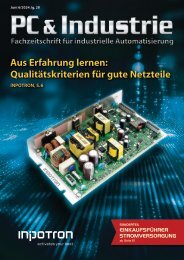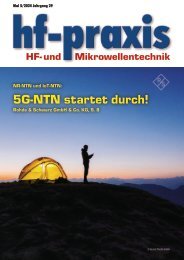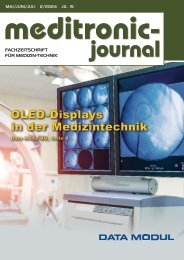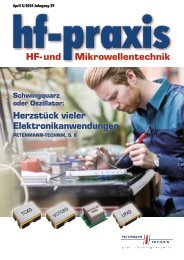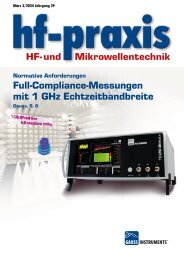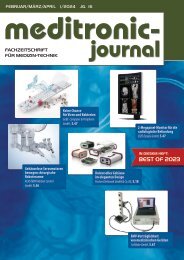12-2018
Fachzeitschrift für Hochfrequenz- und Mikrowellentechnik
Fachzeitschrift für Hochfrequenz- und Mikrowellentechnik
Erfolgreiche ePaper selbst erstellen
Machen Sie aus Ihren PDF Publikationen ein blätterbares Flipbook mit unserer einzigartigen Google optimierten e-Paper Software.
mmWave Automotive Radar and Antenna<br />
System Development<br />
As modern vehicle<br />
development expands<br />
to include more and<br />
more sophisticated<br />
electronics, automobile<br />
manufacturers are<br />
equipping their new<br />
models with advanced<br />
driver-assistance<br />
systems (ADAS) to<br />
obtain high safety<br />
ratings by increasing<br />
automotive safety.<br />
AWR Application Note<br />
National Instruments<br />
www.ni.com/awr<br />
Figure 1: Different ranges, fields-of-view (FOV), and functions for advanced<br />
driver assist systems<br />
Most road accidents occur due<br />
to human error and ADAS are<br />
proven to reduce injuries and<br />
fatalities by alerting drivers to<br />
and assisting them with a variety<br />
of issues, including collision<br />
avoidance and low tire pressure<br />
using radar technology mostly<br />
focused over the 76...81 GHz<br />
spectrum. They perform over<br />
a range of applications, operating<br />
conditions, and object<br />
detection challenges in order to<br />
provide reliable coverage over<br />
the range (distance) and field of<br />
view (angle) as dictated by the<br />
particular driver assist function.<br />
This application note presents<br />
some of the challenges behind<br />
developing millimeter-wave<br />
(mmWave) radar systems and<br />
the antenna array technologies<br />
for the next generation of smart<br />
cars and trucks. Examples will<br />
be presented demonstrating how<br />
the NI AWR Design Environment<br />
platform, specifically the<br />
radar design capabilities within<br />
Visual System Simulator (VSS)<br />
system design software, can<br />
be used successfully in ADAS<br />
applications.<br />
ADAS Technology<br />
ADAS is made possible through<br />
a network of sensors that perform<br />
specific safety functions. Manufacturers<br />
are currently implementing<br />
these systems based<br />
on vision sensor technology<br />
and radar systems operating at<br />
either 24 and/or 77 GHz. Vision<br />
systems detect lane markings<br />
and process other visual road<br />
information, however, they are<br />
susceptible to inadequate performance<br />
due to precipitation,<br />
particularly snow and fog, as<br />
well as distance.<br />
On other the hand, long-range<br />
radar (LRR) supports multiple<br />
functions, comfortably handling<br />
distances between 30 and 200 m,<br />
and short-range radar (SRR) can<br />
detect objects below 30-meter<br />
distances. While the 24 GHz<br />
frequency band, which addresses<br />
SRR detection, is expected<br />
to be phased out of new vehicles<br />
by 2022, today it is commonly<br />
found in hybrid architectures.<br />
Meanwhile, the 77 GHz band<br />
(from 76 to 81 GHz) supporting<br />
LRR is expected to provide<br />
both short and long-range<br />
detection for all future automotive<br />
radars. Figure 1 provides<br />
details on short/medium and<br />
long-range radar.<br />
Technical advantages of the 77<br />
GHz band include smaller antennas<br />
(one-third of the size of the<br />
current 24 GHz ones), higher<br />
permitted transmit power, and,<br />
most importantly, wider available<br />
bandwidth, which enables<br />
higher object resolution. As a<br />
result, advances in radar modulation<br />
techniques, antenna beam<br />
steering, system architecture,<br />
and semiconductor technology<br />
are driving the rapid adoption of<br />
mmWave radar in future ADAS<br />
enabled cars and trucks.<br />
To manage the adoption of these<br />
technologies, radar developers<br />
require RF-aware system design<br />
software that supports radar<br />
simulations with detailed analysis<br />
of RF front-end components,<br />
including nonlinear RF chains,<br />
advanced antenna design, and<br />
channel modeling. Co-simulation<br />
with circuit and electromagnetic<br />
(EM) analysis provides<br />
accurate representation of true<br />
system performance prior to<br />
building and testing costly radar<br />
prototypes. NI AWR software<br />
provides these capabilities, all<br />
within a platform that manages<br />
automotive radar product development—from<br />
initial architecture<br />
and modulation studies<br />
through the physical design of<br />
58 hf-praxis <strong>12</strong>/<strong>2018</strong>



